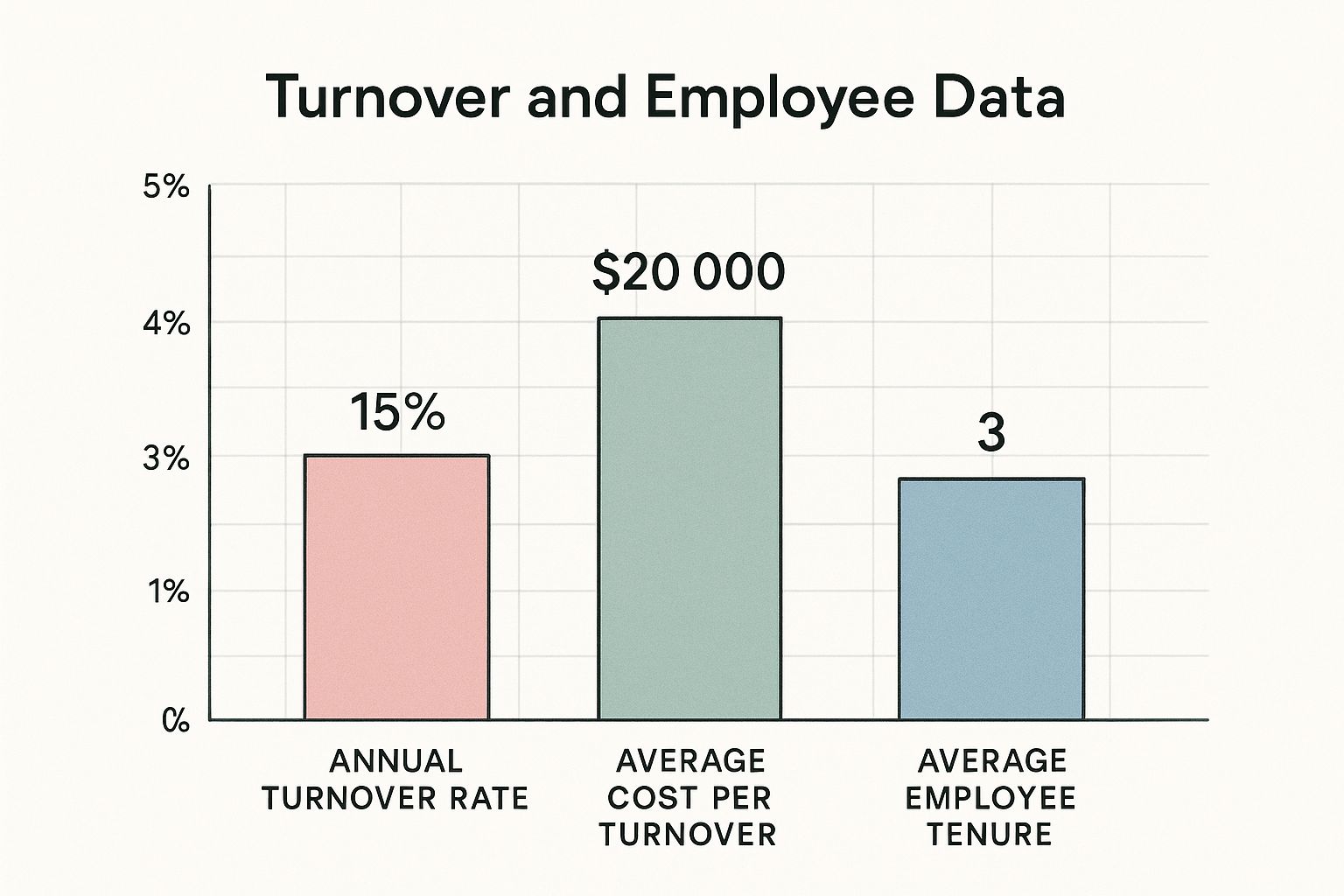How to Reduce Turnover and Retain Top Talent

If you're serious about reducing employee turnover, you need to focus on what really matters: creating a place where people genuinely want to work. This means fostering a strong culture, offering fair compensation and benefits, showing people a clear path for growth, and—crucially—equipping your managers to lead effectively.
Let's break down exactly how to diagnose why people are leaving and build an environment that keeps your best talent.
The Hidden Costs of High Employee Turnover
Losing a good employee is tough. But the real damage goes way beyond a dip in team morale. High turnover is a silent killer of profits, creating a ripple effect of financial and operational problems that many leaders don't fully appreciate.
From the moment an employee gives their notice, the clock starts ticking on replacement costs. It's not just about paying for job ads or a recruiter's fee. Think about the countless hours your own team sinks into sifting through resumes, conducting interviews, and then training the new person. All that time is pulled away from their actual jobs, and that lost productivity adds up fast.
Beyond the Obvious Financial Drain
The costs you don't see on a spreadsheet are often the most damaging. A new hire, no matter how talented, simply isn't as productive as the seasoned employee they replaced. It can take months for them to get fully up to speed.
While they're ramping up, projects can slow down, deadlines get pushed, and the rest of the team is left picking up the slack. This added pressure is a fast track to burnout, which can trigger even more resignations. It becomes a vicious cycle.
"When experienced employees walk out the door, they take valuable knowledge and skills with them. It can take months for new hires to get fully up to speed."
Worse yet, this brain drain erodes your company's institutional knowledge. Every departure creates a small gap in how things get done, how problems are solved, and who knows what. Over time, those gaps can seriously hinder innovation and smart decision-making. And don't forget your customers. They rely on consistent relationships, and when their go-to person suddenly leaves, that trust can be shaken.
Each departure sends a shockwave through the entire employee life cycle, undermining everything from engagement to overall stability.
The numbers really bring the issue into focus.

As you can see, even a seemingly small turnover rate carries a hefty price tag. It's a stark reminder that keeping your people should be a core business strategy, not just an HR initiative.
Estimated Cost of Turnover by Employee Level
To really understand the financial hit, it helps to break down the costs by employee level. The more senior the role, the more expensive it is to find, hire, and train a replacement. According to research from the Society for Human Resource Management (SHRM), the cost can range from a few thousand dollars for an entry-level position to several times an executive's salary.
| Employee Level | Annual Salary (Example) | Estimated Replacement Cost (as % of Salary) | Estimated Financial Impact |
|---|---|---|---|
| Entry-Level | $45,000 | 20-30% | $9,000 - $13,500 |
| Mid-Level/Manager | $90,000 | 50-150% | $45,000 - $135,000 |
| Senior/Executive | $200,000 | Up to 210% | Up to $420,000 |
Source: Varies by source, figures based on compiled data from SHRM and the Center for American Progress.
These figures make it crystal clear why a 2021 survey by Willis Towers Watson found that 87% of HR managers say retention is a top priority. The cost of losing a senior leader can be absolutely staggering.
Recognizing these hidden costs is the critical first step. To dig deeper into the problem and find practical solutions, this guide on how to reduce employee turnover is an excellent resource.
Ultimately, investing in your people isn't just a nice thing to do—it's a direct investment in your company's long-term health and profitability.
Figuring Out Why Your Best People Are Walking Away

Before you can fix a turnover problem, you have to stop guessing and start diagnosing. I’ve seen so many well-intentioned retention strategies fall flat because they were aimed at the wrong issues. If you want real results, you need to shift from relying on whispers in the hallway to a solid, data-driven understanding of why your talent is heading for the exit.
The first step is taking a hard look at your turnover rate. A single, company-wide number is a start, but the truly valuable insights are buried deeper. You need to slice and dice that data to find the hidden “hotspots” where turnover is hitting you the hardest.
Finding Your Turnover Hotspots
Blanket solutions are a waste of resources because the reasons people leave can be completely different from one team to the next. The goal here is to pinpoint exactly where the fires are burning so you can focus your efforts.
Start by breaking down your numbers through a few critical lenses:
- By Department: Is your engineering team rock-solid, but your sales team feels like a revolving door? This could point to anything from a flawed commission structure to burnout or team-specific leadership issues.
- By Manager: This is a big one. A manager with a consistently high turnover rate on their team is a massive red flag. We’ve all heard it before, but it’s true: people don’t leave companies, they leave managers. In fact, a Gallup study found that managers account for at least 70% of the variance in employee engagement scores across business units.
- By Tenure: Are new hires jumping ship within their first 6-12 months? That’s a clear sign of a problem with your onboarding or a major disconnect between the job they were sold and the reality of the role. If it’s your veterans leaving, you might be looking at a lack of growth opportunities or career stagnation.
- By Performance: Losing your top performers is a five-alarm fire. It’s far more damaging than losing someone who was struggling anyway. If your A-players are leaving, it’s a critical warning that something in your culture isn't supporting their ambition and growth.
Segmenting your data this way turns a single, overwhelming number into a focused map, showing you exactly where to intervene first.
Getting Honest Feedback Beyond the Numbers
Data tells you what is happening, but only real conversations can tell you why. While the numbers identify your hotspots, it’s the qualitative feedback that uncovers the root causes—a toxic team dynamic, uncompetitive pay, or a simple lack of meaningful work. You have to create safe channels for people to tell you the truth.
Exit interviews are your last chance to learn from someone on their way out. To get truly candid feedback, though, it’s often best to have a neutral third party, like someone from HR, conduct the interview. Employees are far more likely to open up about their real reasons for leaving if they aren’t talking directly to the manager they’re trying to escape.
The most powerful insights often come from the people who are still committed to your company. Proactively asking what keeps your best employees happy—and what might make them leave—is a game-changing retention strategy.
This is where stay interviews come into play. These are proactive, informal check-ins with your current high-performers. The goal is to understand what they love about their job and what could be better. Asking simple questions like, "What do you look forward to when you come to work?" or "If you had a magic wand, what's one thing you would change about your role?" can reveal potential issues long before they turn into resignation letters.
Finally, engagement surveys give you a broad, anonymous pulse check on morale across the entire organization. When done right, they can measure everything from trust in leadership to satisfaction with career development. They’re an incredible tool for spotting trends over time and identifying systemic problems. If you need help getting started, you can find some great examples of effective employee engagement survey questions to make sure you’re asking the right things.
When you combine the hard data with the human stories behind it, you move from assumption to certainty. This diagnostic work is the essential foundation for building a retention strategy that actually works.
Building a Culture People Don't Want to Leave

Let’s be honest: perks like free snacks and ping-pong tables don't keep people around. The real secret to retention is a culture so good, your best employees wouldn’t dream of leaving. This kind of "sticky" culture is the invisible force that makes people excited to show up and hesitant to look elsewhere.
It’s built on a foundation of trust, transparent communication, and a shared belief in what you're doing. It’s an environment that leaders have to deliberately create and constantly protect. Because when people feel genuinely valued, respected, and connected to the mission, their loyalty runs deep.
The data backs this up. The 2025 Employee Retention Index, as reported by Inspirus, recently dropped 6.2 points to 98.5, and a big driver was a 3.1-point decline in cultural satisfaction. This isn't just a number—it’s a warning sign. A weak culture is a direct threat to your stability and a primary reason people start polishing their resumes. You can dig into the full report to see just how much these trends matter.
Creating Psychological Safety
At the very core of a great culture is psychological safety. It's that unspoken feeling that allows team members to speak up, take calculated risks, and even admit they messed up without fearing they'll be shamed or punished.
When you have this safety net, something incredible happens: people bring their best ideas to the table and flag small issues before they snowball into massive problems.
Leaders are the chief architects here. They set the tone by being vulnerable themselves, admitting their own mistakes, and genuinely asking for different points of view. It sends a clear signal that it’s okay to be human and that every voice is important.
Here are a few simple but powerful things managers can do to build this:
- Kick off a meeting by sharing a small failure or a lesson you learned recently. It immediately normalizes imperfection.
- When someone challenges an idea, thank them for it. Frame that kind of debate as a strength, not a conflict.
- When a mistake happens, swap blame for curiosity. Instead of "Who did this?" ask, "What can we learn from this?"
These small shifts create a positive feedback loop. Trust grows, collaboration gets better, and your team feels secure enough to bring their whole selves to work.
Connecting Daily Work to a Larger Purpose
Most people want to feel like their work matters. They’re looking for a connection between their day-to-day tasks and something bigger than the bottom line. A strong culture constantly reinforces this connection.
This has to go way beyond a mission statement collecting dust on a wall. Leaders need to be translators, constantly showing how each person's role moves the company's purpose forward.
When employees can draw a straight line from their efforts to the company's impact on a customer or the community, their work takes on real meaning. That feeling is a much more powerful motivator than a paycheck alone.
Think about it this way: a software developer isn't just shipping code; they're building a tool that helps a small business owner save precious time. A customer service rep isn't just answering calls; they're solving a real person's problem and making their day better. If you want more strategies on this, our guide on building culture at work is a great resource.
Making Recognition and Inclusion Non-Negotiable
A place where people feel seen, valued, and included is a place they’ll fight to stay. To get there, you need two things: authentic recognition and a serious commitment to diversity, equity, and inclusion (DEI).
The best recognition is timely, specific, and sincere. A quick, personal "thank you" for a specific contribution often carries more weight than a generic "employee of the month" plaque. Better yet, encourage peer-to-peer recognition—it builds stronger team bonds and ensures no great work goes unnoticed.
At the same time, DEI can't just be an HR initiative; it has to be part of your company's DNA. That means:
- Ensuring you have diverse representation in your leadership ranks.
- Supporting employee resource groups (ERGs) to help people find their community.
- Building hiring and promotion processes that are designed to root out bias.
When every employee, regardless of their background, feels they have a fair shot to succeed and that their unique perspective is an asset, you cultivate a deep sense of belonging. And that feeling is one of the most powerful anchors you have for keeping your top talent.
Rethink Your Onboarding and Map Out Career Paths
Those first few months on the job are a make-or-break moment. Think of it less as a time for filling out forms and more as a period where a new hire is deciding if they made the right call by joining your team. A sloppy, disorganized welcome is a huge red flag. It tells them you weren't ready for them, and that seed of doubt is often the first step toward an early exit.
On the flip side, a thoughtful, structured, and genuinely welcoming onboarding process confirms they made a great choice. It turns what could be a purely transactional process into a human one, building real connections and clarity from day one. You're not just hiring someone; you're setting them up for a long and successful run with your company.
Go Beyond Paperwork to Purposeful Integration
Great onboarding is so much more than a checklist. It's a carefully planned experience, and the numbers back this up: companies with a strong onboarding process boost new hire retention by 82% and see a 70% jump in productivity, according to research compiled by Glassdoor. It’s your single best opportunity to show a new person exactly how they fit into the bigger picture.
To get this right, you have to move past the administrative basics.
- Forge Social Connections: Don't just point them to their desk and walk away. Assigning an onboarding "buddy"—someone who isn't their manager—gives them a safe person to ask the "dumb" questions. It helps them build social roots and feel like part of the community faster.
- Set Crystal-Clear Expectations: A solid 30-60-90 day plan is a game-changer. It gets rid of ambiguity and gives the new hire a roadmap with specific goals and milestones. They need to know what success looks like in their first three months.
- Immerse Them in the Culture: Get them talking to people! Schedule brief one-on-ones with key team members across different departments. This isn't just a meet-and-greet; it helps them understand how the business really works and see the company's mission and values in action.
For a more detailed look, our guide on new employee onboarding best practices provides a full blueprint for creating an experience that makes top talent want to stay.
Pave Clear Paths for the Future
Once you've successfully welcomed a new hire, the conversation has to shift to what's next for them. It's a sobering statistic, but a 2021 study by HR analytics firm Visier found that 34% of workers feel they don’t have enough room to grow in their current company. That feeling of hitting a wall is a massive driver of turnover, especially for your most ambitious people.
If your team can't see a future with you, they'll start building one somewhere else. You have to be intentional about creating and communicating clear pathways for growth. This shows your people you're invested in them as professionals, not just in what they can produce for you today.
Showing an employee a path forward is one of the most powerful retention tools you have. When people feel you are actively investing in their future, their loyalty and engagement skyrocket.
And remember, growth isn't always a straight line up the ladder. It can mean mastering a new skill, taking the lead on a challenging project, or even making a lateral move to a different department to broaden their experience.
Build a Culture of Internal Mobility
Investing in career development isn't just a defensive move to stop people from leaving; it's how you build a stronger, more capable team from the inside out. When you prioritize internal mobility, you create a dynamic environment where people see that learning and growing are genuinely valued and rewarded.
Here are a few practical ways to build this culture:
- Offer Skill-Building Opportunities: Provide access to online courses, offer tuition reimbursement, or give out learning stipends. This empowers your team to gain new skills that can prepare them for their next role right inside your company.
- Have Regular Development Conversations: Don't save career talks for the annual review. Managers should be discussing goals and aspirations in their regular one-on-ones, making development an ongoing, natural part of the conversation.
- Promote from Within—First: Make it a standard practice to post all open roles internally before looking outside. When your employees see their colleagues getting promotions and new opportunities, it sends a clear message: loyalty and hard work pay off here.
When you get right down to it, a great onboarding experience locks in an employee's initial commitment. But it’s the clear, visible career paths that give them compelling reasons to stay and build their future with you.
Turning Managers into Retention Champions

You’ve probably heard the old saying, "people leave managers, not companies." It’s a cliché for a reason—it's almost always true. You can have the best perks and a killer mission statement, but if you ignore the single biggest influence on an employee's daily life, your retention strategy will fall flat.
That influence? Your frontline leaders. Investing in your managers is the highest-impact retention activity you can possibly undertake.
When managers have the right skills, they stop being taskmasters and become genuine coaches. They build trust, champion their team’s growth, and create an environment where your best people actually want to stay.
Failing to build up your managers has a real, tangible cost. Data from Apollo Technical shows that every single departure can cost you roughly one-third of that person’s annual salary. It adds up fast, and organizations hemorrhaging talent are about 23% less profitable than those with strong retention. If you want to dig deeper, you can discover more insights about employee retention statistics.
The Core Competencies of a Retention-Focused Manager
So, what does a manager who keeps their people actually do? It's less about tracking metrics and more about mastering the human side of leadership.
A manager's ability to keep their team intact really boils down to a few key skills:
- Giving Constructive Feedback: Too many managers either avoid giving feedback entirely or deliver it so poorly that it crushes morale. Great managers offer feedback that’s specific, timely, and focused on behavior, not personality. They help people grow without making them feel attacked.
- Meaningful Recognition: This isn't about a generic "good job" in the team chat. It's about spotting specific contributions and connecting them to the bigger picture. A simple, personal "thank you" for a specific accomplishment can do more for an employee's sense of value than a gift card.
- Demonstrating Genuine Care: People stick around when they feel their manager sees them as a human being, not just a resource. This means showing empathy, respecting work-life boundaries, and actually checking in on their well-being.
A manager's primary role isn't just to oversee work; it's to create the conditions for their team to succeed and feel fulfilled. When they get that right, retention becomes a natural byproduct of great leadership.
Actionable Training for Modern Leaders
You can't just promote your top salesperson and expect them to magically know how to lead. You have to give them the tools. Your manager training should be focused on practical skills they can use tomorrow, not abstract theories.
Emotional Intelligence (EQ) A manager with high EQ can read a room, pick up on unspoken team concerns, and keep their cool under pressure. Your training should include real-world scenarios, like how to handle a tough conversation with an underperforming employee or how to respond with empathy when someone is struggling personally.
Conflict Resolution Great managers don't let conflict fester; they address it head-on. Give them a simple framework for mediating disputes, encouraging open dialogue, and helping team members find common ground. This skill is absolutely essential for maintaining a healthy, psychologically safe team.
Running One-on-One Meetings That Matter Let's be honest: most one-on-ones are boring status updates that everyone dreads. It’s time to train your managers to turn these meetings into powerful coaching sessions.
An effective one-on-one should be:
- Employee-Led: The manager is there to listen, ask questions, and guide—not to dominate the conversation.
- Forward-Looking: The focus should be on career goals, development opportunities, and knocking down roadblocks.
- Consistent and Protected: These meetings should be sacred. When a manager constantly cancels, it sends a clear message that their employee isn't a priority.
By investing in these core skills, you give your managers the power to build the kind of trust that makes people want to stay. This isn't just about plugging a leaky bucket; it's about building a stronger, more resilient organization from the ground up.
Common Questions About Reducing Turnover
Once you start putting new retention strategies into play, a whole new set of questions almost always pops up. It's one thing to have a plan, but it's another to navigate the day-to-day realities of making it work. Let's tackle some of the most common hurdles so you can move forward with a clear head.
How Quickly Will We Actually See Results?
It's tempting to look for a quick fix, and while correcting a glaring issue like below-market pay can give you an almost immediate morale boost, real change takes time. Meaningful drops in your turnover rate don't happen overnight because they're the result of deep, cultural shifts and better management habits.
A realistic timeframe to see a measurable impact on your numbers is anywhere from 6 to 12 months. The trick is to watch your leading indicators. Are employee engagement scores ticking up? Is the feedback you're getting in stay interviews becoming more positive? These are the early signs that you're heading in the right direction, long before your annual turnover stats will prove it.
We're on a Tight Budget. What's Our Best Bet?
If your resources are limited, the single most powerful investment you can make is in your managers. This one costs more in time and focus than it does in dollars, but the returns are huge.
Zero in on training your managers to master a few key skills:
- Giving consistent, genuinely helpful feedback.
- Recognizing their people's work in a way that feels authentic.
- Conducting one-on-one meetings that are actually valuable, not just a formality.
These core actions are what build the foundation of trust and respect that makes people stick around. For smaller companies trying to get this right, a comprehensive guide on mastering HR in a small business can be an invaluable resource.
Should We Fix Compensation or Culture First?
This is the classic "chicken or egg" debate in retention, but the truth is, you can't choose one over the other. They solve different pieces of the same puzzle.
Think of it this way: competitive compensation gets you in the game. If your pay isn't in the right ballpark, you'll lose great people before you even have a chance to show them your amazing culture. It's the baseline requirement to even be considered.
But a strong, positive culture is what makes people want to stay for the long haul. It's the reason someone turns down a recruiter's call for a 10% raise elsewhere. Pay gets them on the team, but culture makes them want to win the championship with you.
How Can I Get Leadership to Invest in Retention?
To get buy-in from the C-suite, you have to speak the language they understand best: money. Stop framing retention as a fuzzy HR initiative and start presenting it as a strategic investment with a solid return.
You need to build a business case grounded in your own company's data. Calculate your current turnover rate and then show them the real cost. A frequently cited statistic from the Work Institute suggests a conservative estimate for replacing a single employee is 33% of their annual salary. When you start adding that up, the numbers get big, fast.
Lay it out for them. "If we reduce turnover by just 5%, we'll save X amount of dollars, which is five times the cost of the program I'm proposing." This data-first approach transforms the conversation from a "nice-to-have" people project into a smart, financially-sound business decision.
At MyCulture.ai, we give you the tools to build a culture that makes your best people want to stay. Our platform helps you understand culture fit from the very beginning and gives your managers the insights they need to build an environment where talent can truly thrive. Discover how MyCulture.ai can transform your retention strategy.